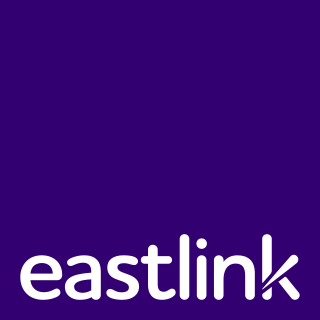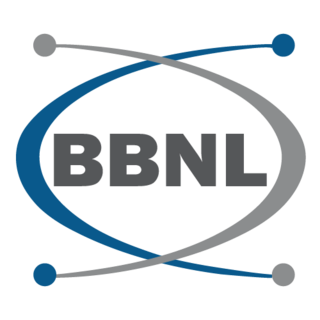Present-day telecommunications in Canada include telephone, radio, television, and internet usage. In the past, telecommunications included telegraphy available through Canadian Pacific and Canadian National.

Telecommunications infrastructure in South Africa provides modern and efficient service to urban areas, including cellular and internet services. The Independent Communications Authority of South Africa (ICASA) is the watchdog of the telecommunications in the country.

Bell Canada is a Canadian telecommunications company headquartered at 1 Carrefour Alexander-Graham-Bell in the borough of Verdun in Montreal, Quebec, Canada. It is an ILEC in the provinces of Ontario and Quebec; as such, it was a founding member of the Stentor Alliance. It is also a CLEC for enterprise customers in the western provinces.
Craig Wireless Systems, Ltd. is a Canadian company which offers Multichannel Multipoint Distribution Service in Manitoba and British Columbia.
Bell MTS Inc. is a subsidiary of BCE Inc. that operates telecommunications services in Manitoba.

Shaw Communications Inc. was a Canadian telecommunications company which provided telephone, Internet, television, and mobile services. The company was founded in 1966 as Capital Cable Television Company, Ltd. by JR Shaw in Edmonton. The company was acquired by and amalgamated into Rogers Communications in 2023; most operations were rebranded to the Rogers brand beginning in July of that year.
Northwestel Inc. is a Canadian telecommunications company that is the incumbent local exchange carrier (ILEC) and long-distance carrier in the territories of Yukon, the Northwest Territories, Nunavut, and part of Northern British Columbia. Originally established in 1979 by the Canadian National Railway from CN's northern telecommunications assets, it has been owned by BCE Inc. since 1988.
Saskatchewan Telecommunications Holding Corporation, operating as SaskTel, is a Canadian crown-owned telecommunications firm based in the province of Saskatchewan. Owned by the provincial government, it provides wireline and wireless communications services, including landline telephone, mobile networks, broadband internet, IPTV, and security services. Through a subsidiary, SaskTel International, the company has also worked on telecom infrastructure projects in countries such as Argentina and the Bahamas, as well as being the lead implementation company for the communication and control systems of the Channel Tunnel between England and France.

Eastlink is the operating name of Bragg Communications Inc., a Canadian cable television and telecommunications company. The privately held company was founded in Nova Scotia in 1969 by the Bragg family, and has grown since through the amalgamation of several telecommunications companies.
Alberta Provincial Highway No. 1, commonly referred to as Highway 1, is a major east–west highway in southern Alberta that forms the southern mainline of the Trans-Canada Highway. It runs from the British Columbia border near Lake Louise through Calgary to the Saskatchewan border east of Medicine Hat. It continues as Highway 1 into both provinces. It spans approximately 534 km (332 mi) from Alberta's border with British Columbia in the west to its border with Saskatchewan in the east. The route is a divided four-lane expressway throughout the province with the exception of a section in central Calgary where it is an arterial thoroughfare carrying four to six lanes. The highway is a freeway between the Sunshine exit near the town of Banff and Home Road in Calgary. Other rural sections have at-grade intersections with interchanges only at busier junctions. Twinning of the final 8.5 km (5.3 mi) of Highway 1 between Lake Louise and the British Columbia border was completed by Parks Canada and opened to traffic on June 12, 2014, making the whole length of Alberta Highway 1 a divided minimum four-lane route.

Tbaytel, formerly the Thunder Bay Telephone Company, is a municipally-owned telecommunications company operating in Thunder Bay, Ontario, Canada, and the surrounding area. Tbaytel's services include data, voice, wireless, internet, digital TV and security.
In audio and broadcast engineering, Audio over Ethernet is the use of an Ethernet-based network to distribute real-time digital audio. AoE replaces bulky snake cables or audio-specific installed low-voltage wiring with standard network structured cabling in a facility. AoE provides a reliable backbone for any audio application, such as for large-scale sound reinforcement in stadiums, airports and convention centers, multiple studios or stages.
CKMX was a radio station broadcasting at 1060 AM in Calgary, Alberta, and owned by Bell Media. Its comedy format was branded on-air as Funny 1060. CKMX's studios were located in the CTV Calgary Studios on Patina Rise SW in the Prominence Point neighborhood of Calgary, and its transmitter site near Southeast Calgary. At night, CKMX could be heard as far west as Battle Ground and Snohomish, Washington. It could also be heard on shortwave on 6.03 MHz via its repeater CFVP, reaching western North America.
Internet in Australia first became available on a permanent basis to universities in Australia in May 1989, via AARNet. Pegasus Networks was Australia's first public Internet provider in June 1989. The first commercial dial-up Internet Service Provider (ISP) appeared in capital cities soon after, and by the mid-1990s almost the entire country had a range of choices of dial-up ISPs. Today, Internet access is available through a range of technologies, i.e. hybrid fibre coaxial cable, digital subscriber line (DSL), Integrated Services Digital Network (ISDN) and satellite Internet. In July 2009, the federal government, in partnership with the industrial sector, began rolling out a nationwide fibre-to-the-premises (FTTP) and improved fixed wireless and satellite access through the National Broadband Network. Subsequently, the roll out was downgraded to a Multi-Technology Mix on the promise of it being less expensive and with earlier completion. In October 2020, the federal government announced an upgrade by 2023 of NBN fibre-to-the-node (FTTN) services to FTTP for 2 million households, at a cost of A$3.5 billion.
Internet access is widely available in New Zealand, with 94% of New Zealanders having access to the internet as of January 2021. It first became accessible to university students in the country in 1989. As of June 2018, there are 1,867,000 broadband connections, of which 1,524,000 are residential and 361,000 are business or government.

Canada ranks as the 21st in the world for Internet usage with 31.77 million users as of July 2016 (est), making up 89.8% of the population. According to Harvard researchers, Canada has some of the lowest internet standards among OECD countries, as a result of high costs and slow internet speeds.
Axia NetMedia designs and operates the wholesale component of several "Open Access" fibre based internet and data networks. Axia operates the Alberta SuperNet and is half owner of Covage networks, developing high speed networks in France. It as also been awarded the tender for the Singapore fibre network as part of the OpenNet consortium with Singapore Telecom, and has placed a bond to allow it to submit a proposal for Australia's National Broadband Network.
Sandra Jansen is a Canadian politician who was a member of the Legislative Assembly of Alberta representing the electoral district of Calgary-North West. She served as the Minister of Infrastructure between October 2017 and April 2019.

BharatNet, also known as Bharat Broadband Network Limited (BBNL), is a central public sector undertaking, set up by the Department of Telecommunications, a department under Ministry of Communications of the Government of India for the establishment, management, and operation of the National Optical Fibre Network to provide a minimum of 100 Mbit/s broadband connectivity to all 250,000-gram panchayats in the country, covering nearly 625,000 villages, by improving the middle layer of nation-wide broadband internet in India to achieve the goal of Digital India.

Xplore Inc. is a Woodstock, New Brunswick-based rural internet service provider. It is the largest rural focused broadband service provider in Canada.







